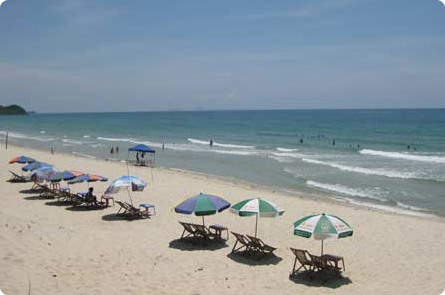Quan Lan is a large island, located in the Van Don island district, in Bai Tu Long Bay, 45 km to northeast of Halong. Quan Lan Island is a large island with an area of 11 square kilometers..


Since the 11th century, Quan Lan had been a centre along the commercial route. In the 12th century, Quan Lan was the first trading port of Vietnam built under the Ly dynasty.
In 1149, King Ly Anh Tong took this place to set up Van Don town and Van Don trading port in order to speed up commercial relationships between Vietnam and Southeast Asian countries. Relics of former trading port have been discovered with traces of ancient architecture and grazed terracotta of metres thick to prove that this place used to be a crowded urban.

In 1288, the beach was also the site of the well-known defeat of invading Mongol troops, who were destroyed by General Tran Khanh Du's army. Tourists in Quan Lan can visit a temple dedicated to the General, where they can learn about the history of the region and the achievements of the commander. The temple's roof is hidden under pine canopies. Approximately 100 steps lead to the temple's entrance that is halfway up a mountain.

Quan Lan has a series of beautiful beaches. Viet My Beach has high, fine white sand & Minh Chau Beach has a beautiful curved sandy shoreline. The clean and clear deep blue waters reflect the white sand and the blue sky. Along the coast is the hundred-year-old Tram Forest.

Cycle on the slopes of the hills, to the beach, across the white sand dunes with many wild flowers, and back to talk with local people. Then you will really feel the “soul” of the island.
The island is also the residence of many aquatic species such as squid, butterfish, mackerel, sea cucumbers, shrimp, etc.
Among the network of inhabited islands, the beautiful isle of Quan Lan still remains largely unexplored. The undeveloped island and its gorgeous white sand beaches have been tagged by major investments that are aiming to expand its shaky tourist infrastructure.

The sand on Quan Lan Beach is stranger than the sand on other beaches. It's white, tiny, pure and smooth. The transparent water allows you to gaze at the bottom of the sea where you can watch fish swim around colourful coral.
Visitors can stay in bungalows on the beach or with locals in a quiet village. In the future, tourists are bound to discover the gorgeous shores of this island paradise, and its unsullied beaches are likely not to stay isolated for too much longer.
For tourists resting on the beach in evening, the illuminations from the lighthouse look like a twinkling star.
The dearth of post-midnight electricity makes night life a wee bit difficult to sustain in this town. During the evening hours, locals and a few tourists stroll along the village's main street, where sugarcane juice vendors and a few cafes stay open. The only sounds that dare to disturb the island are the melodic vibrations of karaoke bursting from living rooms and local cafes.

Sa sung (kind of sea worm) is a speciality of the region. It's used in cooking soup, which helps provide a wonderful taste and adds nutritional sustenance to dishes. Fishing for sa sung with the locals is a popular activity for tourists.
"While men in the village go fishing in the sea, we catch sa sung and sell them to tourists and businesses on the main land as our secondary job," says a local woman.
There are no five-star hotels at Quan Lan Beach, but tourists are able to enjoy a pristine atmosphere that has yet to be overdeveloped

(1).jpg)










.JPG)



